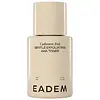What's inside
What's inside
 Key Ingredients
Key Ingredients

 Benefits
Benefits

 Concerns
Concerns

 Ingredients Side-by-side
Ingredients Side-by-side

Water
Skin ConditioningPropanediol
SolventGluconolactone
Skin ConditioningCaprylic/Capric Triglyceride
MaskingLactic Acid
BufferingTranexamic Acid
AstringentSodium Hydroxide
BufferingPrunus Amygdalus Dulcis Oil
Skin ConditioningBetaine
HumectantColloidal Oatmeal
AbsorbentOryza Sativa Bran Water
MaskingTocopherol
AntioxidantSphingomonas Ferment Extract
Skin ConditioningPanthenol
Skin ConditioningLeuconostoc/Radish Root Ferment Filtrate
AntimicrobialAzelaic Acid
BufferingHydrogenated Lecithin
EmulsifyingSodium Citrate
BufferingEthylhexylglycerin
Skin ConditioningPolyglyceryl-10 Stearate
Skin ConditioningCitric Acid
BufferingTrisodium Ethylenediamine Disuccinate
Phenoxyethanol
PreservativeWater, Propanediol, Gluconolactone, Caprylic/Capric Triglyceride, Lactic Acid, Tranexamic Acid, Sodium Hydroxide, Prunus Amygdalus Dulcis Oil, Betaine, Colloidal Oatmeal, Oryza Sativa Bran Water, Tocopherol, Sphingomonas Ferment Extract, Panthenol, Leuconostoc/Radish Root Ferment Filtrate, Azelaic Acid, Hydrogenated Lecithin, Sodium Citrate, Ethylhexylglycerin, Polyglyceryl-10 Stearate, Citric Acid, Trisodium Ethylenediamine Disuccinate, Phenoxyethanol
Water
Skin ConditioningGlycerin
HumectantDipropylene Glycol
HumectantMethyl Gluceth-20
HumectantButylene Glycol
HumectantNiacinamide
SmoothingDimethicone
EmollientCaprylic/Capric Triglyceride
MaskingHeptyl Undecylenate
EmollientHydrogenated Lecithin
EmulsifyingPolypropylsilsesquioxane
Cyclopentasiloxane
EmollientGlycosyl Trehalose
Emulsion Stabilising1,2-Hexanediol
Skin ConditioningCyclohexasiloxane
EmollientHydrogenated Starch Hydrolysate
HumectantDimethicone/Vinyl Dimethicone Crosspolymer
Skin ConditioningHydroxyacetophenone
AntioxidantGlyceryl Stearate
EmollientAcrylates/C10-30 Alkyl Acrylate Crosspolymer
Emulsion StabilisingTromethamine
BufferingSodium Polyacrylate
AbsorbentSodium Acrylate/Sodium Acryloyldimethyl Taurate Copolymer
Emulsion StabilisingXanthan Gum
EmulsifyingIsohexadecane
EmollientAdenosine
Skin ConditioningPolysilicone-11
Disodium EDTA
Polysorbate 80
EmulsifyingCeramide NP
Skin ConditioningAdansonia Digitata Seed Oil
EmollientHydrolyzed Collagen
EmollientParfum
MaskingCentella Asiatica Extract
CleansingSorbitan Oleate
EmulsifyingPolyglucuronic Acid
Skin ConditioningCeramide Ns
Skin ConditioningCeramide As
Skin ConditioningCeramide EOP
Skin ConditioningCeramide AP
Skin ConditioningGlycine Soja Phytoplacenta Extract
Skin ConditioningPolyglyceryl-10 Laurate
Skin ConditioningCaprylyl Glycol
EmollientSodium Hyaluronate
HumectantPropolis Extract
Skin ConditioningAsiaticoside
AntioxidantAsiatic Acid
Skin ConditioningMadecassic Acid
Skin ConditioningMadecassoside
AntioxidantCopper Tripeptide-1
Skin ConditioningPalmitoyl Pentapeptide-4
Skin ConditioningTripeptide-1
Skin ConditioningPalmitoyl Tripeptide-1
Skin ConditioningHexapeptide-9
Skin ConditioningHexapeptide-11
Skin ConditioningWater, Glycerin, Dipropylene Glycol, Methyl Gluceth-20, Butylene Glycol, Niacinamide, Dimethicone, Caprylic/Capric Triglyceride, Heptyl Undecylenate, Hydrogenated Lecithin, Polypropylsilsesquioxane, Cyclopentasiloxane, Glycosyl Trehalose, 1,2-Hexanediol, Cyclohexasiloxane, Hydrogenated Starch Hydrolysate, Dimethicone/Vinyl Dimethicone Crosspolymer, Hydroxyacetophenone, Glyceryl Stearate, Acrylates/C10-30 Alkyl Acrylate Crosspolymer, Tromethamine, Sodium Polyacrylate, Sodium Acrylate/Sodium Acryloyldimethyl Taurate Copolymer, Xanthan Gum, Isohexadecane, Adenosine, Polysilicone-11, Disodium EDTA, Polysorbate 80, Ceramide NP, Adansonia Digitata Seed Oil, Hydrolyzed Collagen, Parfum, Centella Asiatica Extract, Sorbitan Oleate, Polyglucuronic Acid, Ceramide Ns, Ceramide As, Ceramide EOP, Ceramide AP, Glycine Soja Phytoplacenta Extract, Polyglyceryl-10 Laurate, Caprylyl Glycol, Sodium Hyaluronate, Propolis Extract, Asiaticoside, Asiatic Acid, Madecassic Acid, Madecassoside, Copper Tripeptide-1, Palmitoyl Pentapeptide-4, Tripeptide-1, Palmitoyl Tripeptide-1, Hexapeptide-9, Hexapeptide-11
 Reviews
Reviews

Ingredients Explained
These ingredients are found in both products.
Ingredients higher up in an ingredient list are typically present in a larger amount.
This ingredient is an emollient, solvent, and texture enhancer. It is considered a skin-softener by helping the skin prevent moisture loss.
It helps thicken a product's formula and makes it easier to spread by dissolving clumping compounds.
Caprylic Triglyceride is made by combining glycerin with coconut oil, forming a clear liquid.
While there is an assumption Caprylic Triglyceride can clog pores due to it being derived from coconut oil, there is no research supporting this.
Learn more about Caprylic/Capric TriglycerideHydrogenated Lecithin is created from the hydrogenation of lecithin (a group of phospholipids). Hydrogenation is a chemical reaction between hydrogen and another element.
This ingredient is an emollient and emulsifier. As an emollient, it helps soften skin by trapping moisture within. As an emulsifier, it prevents oil and water ingredients from separating.
Water. It's the most common cosmetic ingredient of all. You'll usually see it at the top of ingredient lists, meaning that it makes up the largest part of the product.
So why is it so popular? Water most often acts as a solvent - this means that it helps dissolve other ingredients into the formulation.
You'll also recognize water as that liquid we all need to stay alive. If you see this, drink a glass of water. Stay hydrated!
Learn more about Water